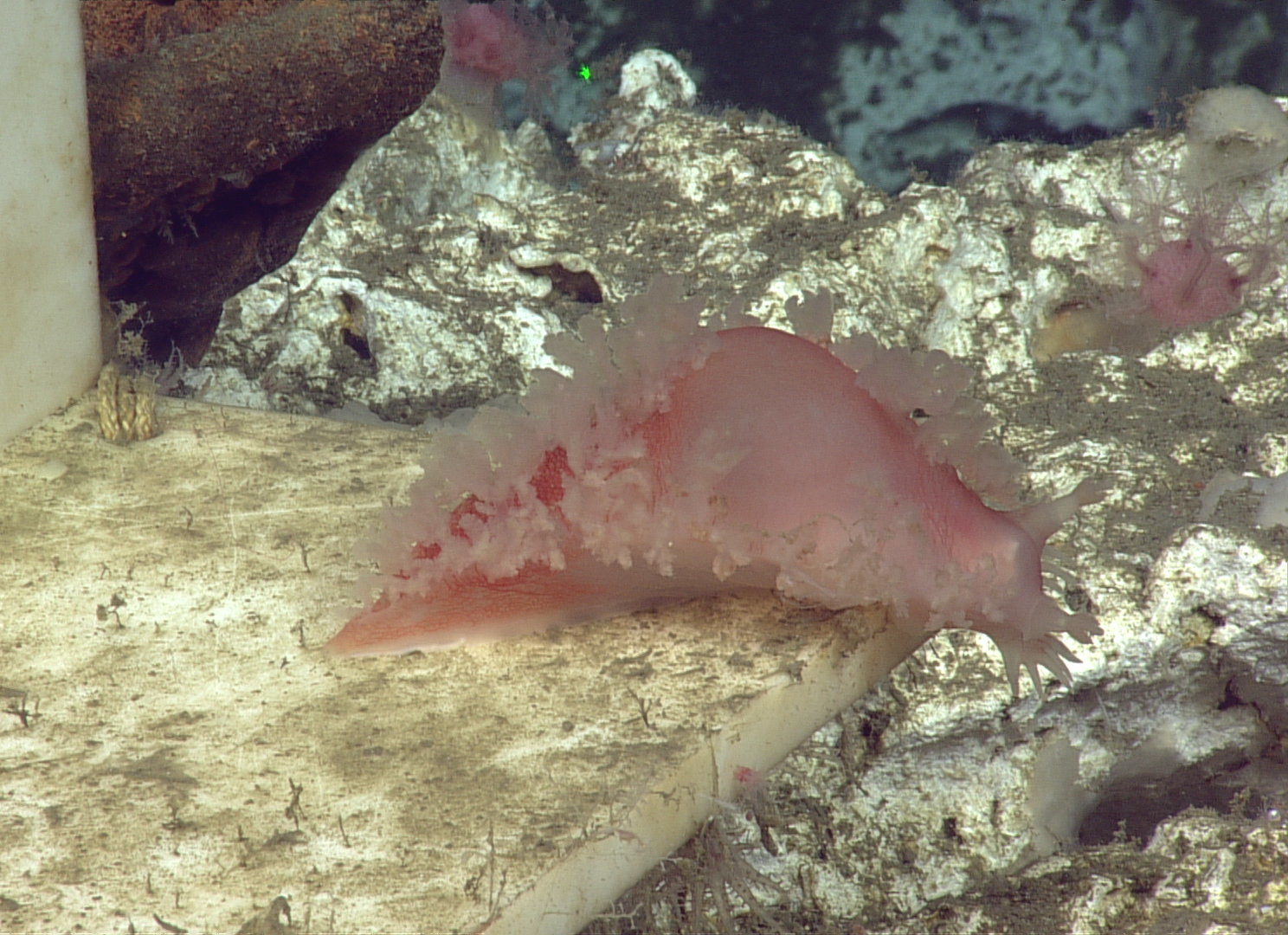The phylum mollusca contains the classes bivalvia, gastropods, and cephalopods. Several species have been documented at coastal sites. These species were documented at Southern Hydrate Ridge and the Endurance Offshore site. Scroll down to learn of several species in these classes of mollusca.
Return to the Coastal Biology home page.
Vesicomyid Clam (Calyptogena sp.)

These clams thrive in hydrogen sulfide rich environments, like the methane seep at Einstein’s Grotto at Southern Hydrate Ridge. These clams have a special feature, a special protein that binds with the sulfide from the water and prevents it from actually entering the clam’s tissues. It also has a very extendable foot that is used to search for sulfide rich sediment. They usually have white shells and are typically partially buried beneath the sediment. Vesicomyid clams typically form clam bed on the outskirts of the microbial mats located at Einstein’s Grotto at Southern Hydrate Ridge around 770 m deep.
References:
https://academic.oup.com/mollus/article/72/4/359/2883183/Recent-bivalve-molluscs-of-the-genus-Calyptogena
www.mbari.org/benthic/Physiologicaladaptationsofclams.html
Babysitter Snails (Neptunea amianta)

These snails lay eggs in a spiral tower and the adult snail sits on top of the tower waiting for the eggs to hatch. Once the eggs hatch the adult snail will fall off and die. The snails were all clustered together along a cable route SUM1W2 at Southern Hydrate Ridge. We did not see the snails at any location other than here. The depth at this location was 776 m. These snails have also been found colonizing primary node 1D at 115 m-water depth. The towers appear to be 8 to 12 inches tall and the adult snail looks to be three inches.
Reference:
Paul Yancey, Whitman College, http://people.whitman.edu/~yancey/ https://montereybay.noaa.gov/research/techreports/trtamburri1999.html
Cockatoo Squid (Galiteuthis phyllura)

Photo Credit: NSF-OOI/UW/CSSF, Dive R1752, V14
The Cockatoo Squid is a species of glass squid. Rather than squirting ink when agitated, it changes the color of its body from transparent to colored by expressing pigment-filled cells called chromatophores. It can grow up to a length of three m. It is able to hold itself motionless in the water column by regulating the ratio of ammonium chloride to seawater that it holds in an internal cavity. They are thought to inhabit depths of 300 m to 1000 m. This Cockatoo Squid was seen at the Oregon Offshore Site at 586 m. It was found floating in the water column, where we witnessed its skin change from dark red to transparent. It was also spotted swimming around ROCLS at Southern Hydrate Ridge at 786 m in depth.
References:
Marine Life Field Guide (Neptune Canada)
http://eol.org/pages/488004/details
http://www.mbari.org/news/homepage/2010/youtube-squids.html
Bushy backed sea slug (Dendronotus frondosus)

The bushy backed sea slug is native to the Arctic, Atlantic, and Pacific Ocean. The sea slug is a nudibranch in the class gastropoda. It feeds on hydroids like the Aglaophenia sp. seen on the shallow profiler, and uses the nematocysts it obtains from it for self-defense. Key characteristics of bushy backed sea slugs are the processes that protrude across its whole body, and the two rows of 5-8 bushy projections along its back. The species of nudibranch varies in colors, and deeper coastal water sea slugs are pale in color compared to those from shallower water. Adults can grow to 100 mm in length. This nudibranch was found on a shallow winched profiler at a depth of 200 m at the cabled Oregon offshore site.
References:
species-identification.org/species.php?species_group=Mollusca&id=647
animaldiversity.org/accounts/Dendronotus_frondosus/
Deep-sea dorid nudibranch (Bathydoris aioca)

Photo credit: NSF-OOI/UW/CSSF, Dive R2258, V22
A large, deep-sea nudibranch, or sea slug, this gastropod is found on soft sediments in the deep NE Pacific. This one was seen near the anchor of the Slope Base Shallow Profiler mooring, and was 30 cm (nearly a foot) long! The feeding tentacles are on the left, the tiny "ears" are rhinophores (chemosensors), and the squiggly things on the right are the gills.
Reference:
http://dsg.mbari.org/dsg/view/concept/Bathydoris%20aioca
Rosy tritonia nudibranch (Tritonia tetraquetra)

Photo credit: NSF-OOI/UW/CSSF, Dive R2228, V22
This large, pink nudibranch can be found all across the North Pacific, but has only rarely been seen around Southern Hydrate Ridge. These mollusks range from the intertidal down to ~700 meters depth and tend to be found on sandy seafloor, especially near sea pens and soft corals, their preferred food source. There are many similar species, but T. tetraquetra can be identified by its massive body (larger than similar species of nudibranch), depth of observation, and the frilly, intermittent set of latitudinal gill tufts along the margin of the dorsal surface.
References:
https://journals.plos.org/plosone/article?id=10.1371/journal.pone.0242103
https://www.mbari.org/know-your-ocean/revealing-the-secrets-of-sur-ridge/life-at-sur-ridge/
Dumbo octopus (Grimpoteuthis sp.)

Photo credit: NSF-OOI/UW/CSSF, Dive R2228, V22
These small cirrate octopuses are the deepest-living known octopus species. They are often seen resting on the bottom or hovering over the seafloor using their prominent, ear-like fins extending from the mantle above the eyes (giving them their common name). They are found worldwide, but have been rarely seen in the Southern Hydrate Ridge area.
